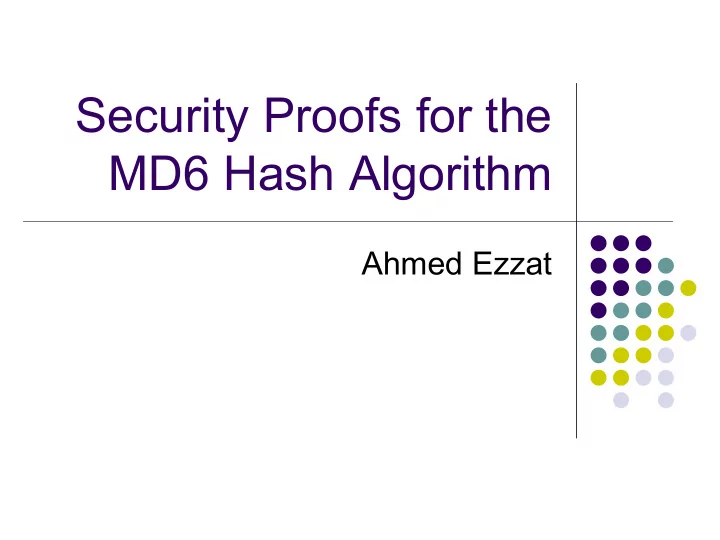

Security Proofs for the MD6 Hash Algorithm Ahmed Ezzat
Outline � Introduction to hash algorithms � NIST SHA-3 Competition � MD6 Algorithm and Mode of Operation � Research Objective � Approach
Introduction to hash algorithms � Hash function definition � Usage Scenarios � Digital Signature � Message Integrity � Password Verification
Introduction to hash algorithms � Properties � Collision resistance � First pre-image resistance � Second pre-image resistance � Pseudo randomness � Unpredictability
NIST SHA-3 Competition � Salted Hashing � Parellizable � Requirements for a message digest of d-bits: � Collision resistance of approximately d/2 bits. � First - preimage resistance of approximately d bits. � Second - preimage resistance of approximately d − k bits for any message shorter than 2 k bits.
MD6 Algorithm and Mode of Operation � Input message structure
MD6 Algorithm and Mode of Operation � Input: A[ 0 .. 88 ] of A[ 0 .. 16r + 88] for i = 89 to 16 r + 88 : = S i ⊕ ⊕ x A[ i-17 ] A[ i-89 ] ⊕ ( A[ i-18 ] ∧ A[ i-21 ] ) ⊕ ( A[ i-31 ] ∧ A[ i-67 ] ) = x ⊕ x ( x >> r i ) = x ⊕ ( x << l i ) A[i] return A[ 16r + 73 .. 16r + 88 ]
MD6 Algorithm and Mode of Operation � Mode of operation snapshot
MD6 Algorithm and Mode of Operation
MD6 Algorithm and Mode of Operation
Properties Remaining � Second pre-image resistance � Unpredictability
Research Objective The continuation of the security proofs for the MD6 hash function mode of operation
Approach � Mathematical � Empirical
References [1] Cryptographic hash function. Available at http://en.wikipedia.org/wiki/Cryptographic_hash_function [2] Christopher Yale Crutchfield. Security Proofs for the MD6 Hash Function Mode of Operation. Available at http://groups.csail.mit.edu/cis/theses/crutchfield-masters-thesis.pdf [3] The MD6 Hash Function. Available at http://groups.csail.mit.edu/cis/md6/submitted-2008-10- 27/Supporting_Documentation/md6_report.pdf
Recommend
More recommend